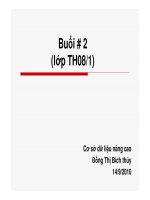Bài tập cơ sở dữ liệu nâng cao tuần 1
Bạn đang xem bản rút gọn của tài liệu. Xem và tải ngay bản đầy đủ của tài liệu tại đây (175.1 KB, 7 trang )
1
CSC380 – Fundamentals of Database Systems
Tutorial # 3
7.16. Consider the following set of requirements for a
UNIVERSITY database that is used to keep track of students'
transcripts. This is similar but not identical to the database shown
in Figure 1.2:
a. The university keeps track of each student's name, student number,
social security number, current address and phone, permanent
address and phone, birth date, sex, class (freshman, sophomore, ...,
graduate), major department, minor department (if any), and
degree program (B.A., B.S., ..., Ph.D.). Some user applications need
to refer to the city, state, and zip of the student's permanent
address, and to the student's last name. Both social security number
and student number have unique values for each student.
b. Each department is described by a name, department code, office
number, office phone, and college. Both name and code have unique
values for each department.
c. Each course has a course name, description, course number,
number of semester hours, level, and offering department. The
value of course number is unique for each course.
d. Each section has an instructor, semester, year, course, and section
number. The section number distinguishes different sections of the
same course that are taught during the same semester/year; its
values are 1, 2, 3, ..., up to the number of sections taught during
each semester.
e. A grade report has a student, section, letter grade, and numeric
grade (0, 1, 2, 3, 4 for F, D, C, B, A, respectively).
Design an ER schema for this application, and draw an ER
diagram for that schema. Specify key attributes of each entity
type and structural constraints on each relationship type. Note
any unspecified requirements, and make appropriate assumptions
to make the specification complete.
1
1
2
2
2
3
Assumptions:
• Every department must have at least one student enrolled in it as a
major
• A student must specify his major when he/she joins the university
• Not all departments are used as a minor department for a student’s
degree
• Every department must offer at least one course
• Every course must belong to exactly one department
• Not all courses will have sections (a course may be new and will not
be offered until next year, or there is no instructor available to teach
the course)
• A section may not have any students enrolled in it
• A student may not sign up for any classes (sections) (for example,
the student dropped that semester for medical reasons
7.17. Composite and multi-valued attributes can be nested to any
number of levels.Suppose we want to design an attribute for a
3
3
4
STUDENT entity type to keep track ofprevious college education.
Such an attribute will have one entry for each collegepreviously
attended, and this entry is composed of: college name, start and
enddates, degree entries (degrees awarded at that college, if
any), and transcriptentries (courses completed at that college,
if any). Each degree entry is formed ofdegree name and the
month and year it was awarded, and each transcript entry
isformed of a course name, semester, year, and grade. Design an
attribute to holdthis information. Use the conventions of
Figure 7.5.
Answer:
{ PreviousEducation ( CollegeName,
StartDate,
EndDate,
{ Degree (DegreeName, Month, Year) },
{ Transcript (CourseName, Semester, Year, Grade) }
)
}
Note (background information, not essential for
examination):
• Note that in Computer Science we usually denote such nested
structures in the BNF notationfor defining
grammars:PreviousEducationList::
PreviousEducation*PreviousEducation: CollegeName StartDate
EndDate Degree* Transcript*Degree : DegreeName Month
YearTranscript : CourseName Semester Year Grade
•
•
•
Selected exercises Chapter 3, Elmasri & Navathe
Problem 7.19
Consider the ER diagram in Figure 7.20, which shows a simplified
schema for an airline reservation system. Extract from the ER
diagram the requirements and constraints that produced this
schema. Try to be as precise as possible in your requirements
and constraints specification.
4
4
5
Airport
- Each airport
- Each airport
- Each airport
- Each airport
must
must
must
must
have
have
have
have
a unique airport code.
a name.
the city listed for which it is located.
the state listed for which it is located.
Airplane
- Each airplane can arrive at an airport during a flight leg.
- Every airplane has a unique airplane id number.
- Every airplane has a maximum capacity (Seats)
Flight
- Each flight has a unique flight number.
- A flight is composed of one or more flight legs.
- Each flight must have a designated airline.
- Each flight leg must have a departure and arrival time defined.
Fare
- Each fare must have a unique code (First class)
- Each fare must have a cost/price.
- Each fare may have restrictions.
Seat
- Each seat has a unique seat number (Seat 14C)
- Each seat is based on a customer reservation.
- Seats are allocated to specific flight legs.
- The number of seats per flight leg cannot exceed the airplane's
maximum capacity.
8.20
5
5
6
6
6
7
7
7









